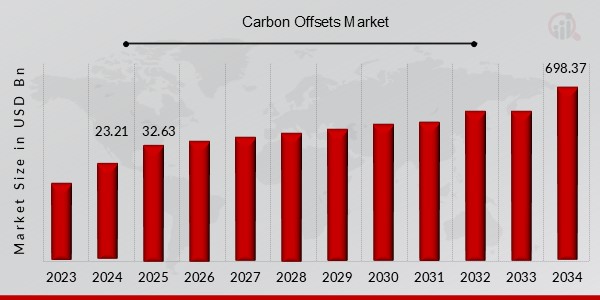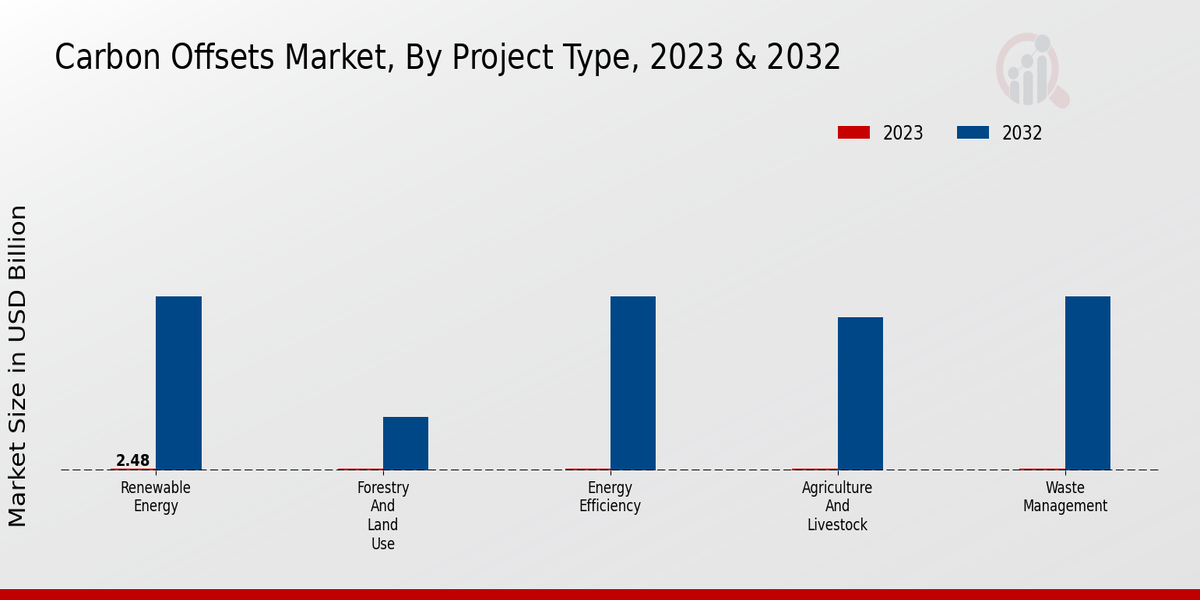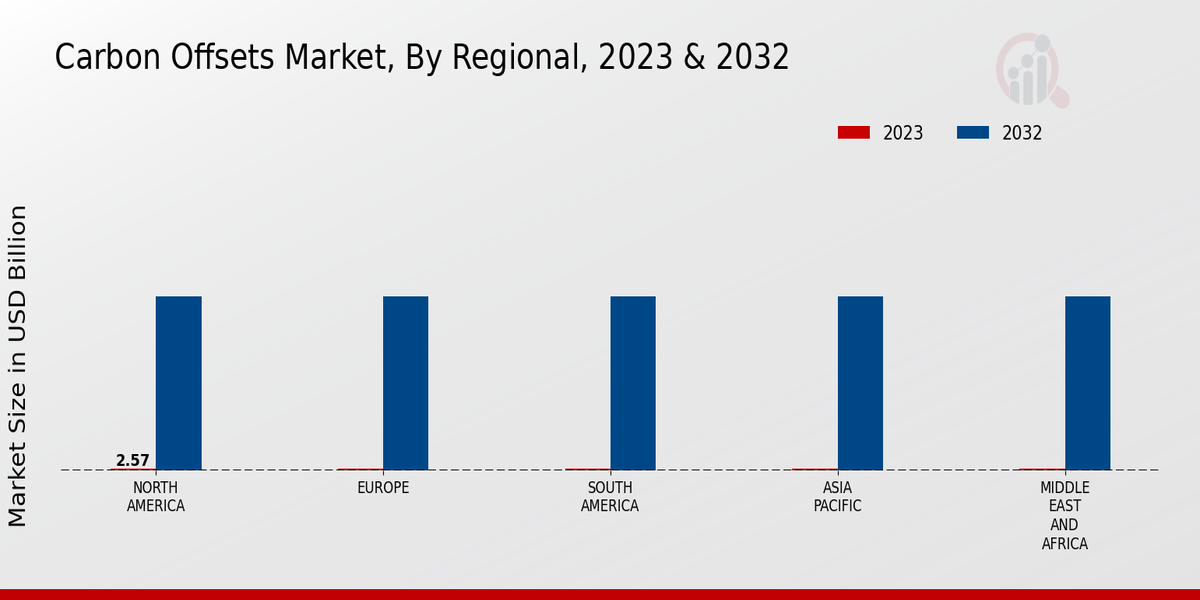Global Carbon Offsets Market Overview
The Carbon Offsets Market Size was estimated at 23.21 (USD Billion) in 2024. The Carbon Offsets Industry is expected to grow from 32.63 (USD Billion) in 2025 to 698.37 (USD Billion) by 2034. The Carbon Offsets Market CAGR (growth rate) is expected to be around 40.55% during the forecast period (2025 - 2034).
Key Carbon Offsets Market Trends Highlighted
The global carbon offsets market embraces the trading of credits that enable companies and organizations to compensate for their carbon emissions by investing in projects that reduce or remove greenhouse gases elsewhere. Key drivers include increasing regulatory pressure, growing corporate sustainability commitments, and rising demand for carbon-neutral products and services. Opportunities for exploration include developing innovative offset mechanisms, expanding the use of technology, and addressing the challenges of double counting and additionality. Recent trends include a surge in demand for high-quality carbon credits, the emergence of new carbon markets, and the increasing role of nature-based solutions in carbon offsetting. Ethical considerations and the need for transparent reporting remain crucial to ensure the integrity and effectiveness of the market.

Source: Primary Research, Secondary Research, MRFR Database and Analyst Review
Carbon Offsets Market Drivers
Increasing Demand for Carbon Credits
The primary reason behind the increasing demand for carbon credits today is the fact that there is an increase in the awareness of climate change. Moreover, the world’s governments mandate that businesses and corporations take environmentally friendly measures in their operations. Consequently, these entities are employing different carbon pricing mechanisms in order to control the amount of carbon that is produced. The methods that can be used include carbon taxing and cap and trade.Either or both of these can be utilized to establish a demand for carbon credits. The demand for carbon credits is expected to continue rising as time goes by.
Corporate Sustainability Initiatives
Many corporations tend to set ambitious sustainability goals, such as reducing their carbon footprint or even reaching net-zero emissions. In the process of achieving these goals, companies are more likely to include carbon offsets. Essentially, carbon offsets allow a company to compensate for emissions that are not avoidable by the company. The company can purchase carbon credits to support various projects that remove or reduce the amount of carbon dioxide in the atmosphere.All in all, a company contributes to a reduction in its own emissions and plays its role in the fight against climate change. This tendency will likely increase the demand for carbon credits in the Global Carbon Offsets Market Industry.
Technological Advancements
In addition to governmental interventions, the Global Carbon Offsets Market Industry has benefited from technological advancements. New technologies for carbon capture and storage and carbon removal are being developed and implemented via the new carbon offset projects, which are more feasible and cost-effective. From a long-term perspective, more carbon offset projects will be created, meaning an increased demand for carbon credits and, hence, their growth opportunities.
Carbon Offsets Market Segment Insights:
Carbon Offsets Market Project Type Insights
The Global Carbon Offsets Market is segmented by Project Type into Renewable Energy, Forestry and Land Use, Energy Efficiency, Agriculture and Livestock, and Waste Management. The Renewable Energy segment is expected to dominate the market with a share of over 40% by 2024. The growth of the Renewable Energy segment can be attributed to the increasing adoption of renewable energy sources such as solar and wind power. The Forestry and Land Use segment is expected to grow at a CAGR of over 12% during the forecast period. The growth of the Forestry and Land Use segment can be attributed to the increasing demand for carbon credits from organizations looking to offset their carbon emissions.The Energy Efficiency segment is expected to grow at a CAGR of over 10% during the forecast period. The growth of the Energy Efficiency segment can be attributed to the increasing demand for energy-efficient technologies and services. The Agriculture and Livestock segment is expected to grow at a CAGR of over 8% during the forecast period. The growth of the Agriculture and Livestock segment can be attributed to the increasing demand for carbon credits from organizations looking to offset their emissions from agricultural activities. The Waste Management segment is expected to grow at a CAGR of over 7% during the forecast period.The growth of the Waste Management segment can be attributed to the increasing demand for carbon credits from organizations looking to offset their emissions from waste management activities.
Source: Primary Research, Secondary Research, MRFR Database and Analyst Review
Carbon Offsets Market Vintage Insights
Global Carbon Offsets Market Vintage – Global Carbon Offsets Market has witnessed robust growth in the past few years across the market segments due to rising demand for high-quality carbon credits. Vintage represents the year in which the reductions in carbon emissions were captured. Pre-2013 vintage credits are valuable across the world largely due to their features, which include scarcity of availability and environmental integrity of the product. Pre-2013 credits represent the emission reductions before 2013 and are hence rare in the market. With the availability of the pre-2013 credits, the vintages below are rare to see in the market.Thus, the market is witnessing a shift towards vintages beyond 2013 and towards the 2013-2016 vintage. The 2013-2016 vintage credits, due to their availability and cost, have been seen as the best replacement for pre-2013 credits. Revenues of these credits are expected to reach $6.5 billion by 2032. 2017-2020 vintage credits are considered to be advantageous due to their cost and environmental impact perspective. Revenues of these credits are expected to grow to $32.1 billion by 2032. The 2021-2023 vintage credits are considered to be the premium vintage in all the markets across the world.The market value for these credits is expected to be $45.6 billion by 2032. The market growth is fueled by the rising adoption of various carbon offset programmes and increasing understanding of the realization and importance of carbon. The 2024-2032 vintage credits are the up-and-coming vintage in all the markets across the world, with a market value of $167.2 billion by 2032. The growth of the market is largely due to the increasing development of carbon capture and storage technologies and the ongoing expansion of the market across the world.
Carbon Offsets Market Carbon Standard Insights
The Verified Carbon Standard (VCS), Gold Standard, American Carbon Registry (ACR), Clean Development Mechanism (CDM), and Climate Action Reserve (CAR) are the leading carbon standards that account for the majority of the Global Carbon Offsets Market revenue. These standards provide a framework for quantifying, verifying, and issuing carbon credits, ensuring the environmental integrity and credibility of carbon offset projects. In 2023, the VCS was the dominant standard, representing over 50% of the global market share. It is recognized for its rigorous verification process and high environmental standards.The Gold Standard is another widely adopted standard, particularly in developing countries, and is known for its focus on sustainable development and community engagement. The ACR is gaining popularity in North America, while the CDM remains significant in emerging markets. The CAR is a leading standard in the United States, with a focus on forestry and agriculture projects. The increasing demand for carbon offsets from corporations and governments seeking to achieve their net-zero targets is driving the growth of the Global Carbon Offsets Market.
Carbon Offsets Market End Market Insights
The Global Carbon Offsets Market has various end markets, including Compliance Markets, Voluntary Markets, Over-the-Counter (OTC) Markets, and Exchange-Traded Markets. Each segment offers distinct opportunities and challenges. Compliance Markets, driven by government regulations, are projected to account for a significant share of the Global Carbon Offsets Market revenue. Voluntary Markets, driven by corporate sustainability initiatives, are also experiencing growth. Over-the-counter (OTC) Markets facilitate bilateral transactions, providing flexibility and customization.Exchange-traded markets, while still in their early stages, offer standardized contracts and increased transparency. These diverse end markets contribute to the overall growth and segmentation of the Global Carbon Offsets Market.
Carbon Offsets Market Offset Origin Insights
In terms of offset origin, the Global Carbon Offsets Market is segmented into domestic and international. Domestic carbon offsets are generated within the same country where they are used, while international carbon offsets are generated in one country and used in another. The international segment held a larger market share in 2023, and it is expected to continue to grow at a faster rate in the coming years. This growth is being driven by the increasing demand for carbon offsets from countries that have adopted ambitious climate change mitigation targets.For instance, the European Union has set a target of reducing its greenhouse gas emissions by 55% by 2030, compared to 1990 levels. This has led to a surge in demand for carbon offsets from developing countries, which have lower abatement costs. The domestic segment, on the other hand, is expected to grow at a slower rate due to the limited availability of cost-effective abatement options in many countries.
Carbon Offsets Market Regional Insights
The regional segmentation of the Global Carbon Offsets Market offers valuable insights into the market's growth dynamics and opportunities. North America is projected to hold a significant share of the market, driven by stringent environmental regulations and increasing corporate sustainability initiatives. Europe is another key region with a focus on renewable energy and carbon reduction targets. APAC presents a rapidly growing market, with China and India emerging as major players due to their expanding industrial sectors and ambitious climate goals.South America and MEA are expected to witness steady growth, driven by increasing awareness and government initiatives to promote carbon neutrality. This growth is attributed to rising carbon emissions, government regulations, and corporate sustainability commitments. The market segmentation provides a comprehensive understanding of the regional dynamics and growth potential, enabling stakeholders to make informed decisions and capitalize on market opportunities.
Source: Primary Research, Secondary Research, MRFR Database and Analyst Review
Carbon Offsets Market Key Players And Competitive Insights:
Ongoing R&D activities to develop innovative carbon capture and storage technologies have prompted major players in the Carbon Offsets Market to invest generously. Companies operating in the carbon offsets market engage in a high degree of merger and acquisition activity, which often takes the form of strategic partnerships and collaborations that result in expanded global reach and enhanced product offerings. The Carbon Offsets Market is fiercely competitive, with players jostling for market share through product offerings, lower costs, and tactical acquisitions. To meet the spiraling demand for carbon offset, major players are concentrating on geographic and product growth. Moreover, government rules and regulations that promote the use of carbon offsetting solutions further the progression of the carbon offsets market. The Carbon Offsets Market Competitive Landscape is also being supported by developments such as digital platform construction and the use of blockchain technology to increase market clarity and efficiency.Players in the sector, such as Verra, a well-known global standard developer and carbon offset certification standards for carbon offset projects, have made significant contributions to the advancement of the Carbon Offsets Market. For authenticity and quality purposes, Verra offers bespoke authentication and certification services that are not tied to the project. Its standards and development credits gold project performance barometer has effectively become the industry standard for carbon offset projects. For the gold Carbon Offsets Market development credits standard, the WRAP program is registered as an eligible intervention and susceptible to monitoring, reporting, and confirmation to affiliate or purchase the resulting carbon credits. The organization Verra works with project developers, validators, and verifiers to guarantee that the intentions of the nascent sector are not impugned in any way.
Key Companies in the Carbon Offsets Market Include:
Carbon Offsets Market Industry Developments
October 2024 : Tesla partnered with a leading carbon offset provider to offset mass emissions from its electric car fleet.
July 2024 : BP announced the launch of a new digital platform intended to increase efficiency in the purchasing process of carbon credits. The strategy will likely enhance inclusion in carbon offset opportunities, mainly targeting the smaller players.
April 2024 : Google funded a carbon arena aimed at reforestation in the Brazillian Amazon rainforest to advance the provision of balance to the organization for its operational emissions over ten years.
December 2024: ICVCM endorses new REDD+ Methodologies: In this context, ICVCM has certified new methodologies for preventing deforestation through forestry projects, collectively labeled as REDD+. The above methodologies have been awarded the Core Carbon Principles (CCP) label, an endorsement that certain quality requirements have been met.
November 2024: New Sources of Meta Study weigh on the credibility of Carbon credits: Another new source of meta-study indicates that over 80 % of carbon credits generated by more than 2000 projects across countries have less climatic impact than what is asserted. This disclosure bears implications on the mitigation capacity and or efforts of the current methods of carbon crediting. It indeed points to a necessary innovation in the market that would improve the validation and the primary functions of the market instruments.
August 2024: Farmers Join the Carbon Credit Schemes: The farmers are becoming active believers in carbon farming and soil carbon sequestration and reforestation practices, which earn them carbon credits. The schemes supplement their income and help the environment by restoring the soil and increasing biodiversity.
In 2023, the International Air Transport Association (IATA) unveiled a new program known as the Carbon Offsetting and Reduction Scheme for International Aviation (CORSIA). CORSIA targets international air travel's carbon emissions by utilizing an “offsetting” approach, whereby airlines are required to buy certain carbon offsets for exceeding a particular emission threshold.
Carbon Offsets Market Report Scope
| Report Attribute/Metric |
Details |
| Market Size 2024 |
23.21 (USD Billion) |
| Market Size 2025 |
32.63 (USD Billion) |
| Market Size 2034 |
698.37 (USD Billion) |
| Compound Annual Growth Rate (CAGR) |
40.55% (2025 - 2034) |
| Report Coverage |
Revenue Forecast, Competitive Landscape, Growth Factors, and Trends |
| Base Year |
2024 |
| Market Forecast Period |
2025 - 2034 |
| Historical Data |
2020 - 2024 |
| Market Forecast Units |
USD Billion |
| Key Companies Profiled |
Forest Carbon Group, Greenhouse Gas Protocol, Carbonfund.org, Puro.Earth, Indigo Agriculture, Emissions Reduction Alberta, Natural Capital Partners, World Bank, Cloverly, Verra, International Carbon Action Partnership, Climeworks, First Climate, South Pole, Cool Effect, Gold Standard, 3Degrees, LandQwest, and EcoAct |
| Segments Covered |
Project Type, Vintage, Carbon Standard, End Market, Offset Origin, Regional |
| Key Market Opportunities |
Carbon capture amp storage technologiesVoluntary carbon marketsBlockchain and smart contractsNature-based solutionsHydrogen production |
| Key Market Dynamics |
1 Increasing corporate sustainability commitments2 Growing demand from regulated industries3 Technological advancements in carbon capture and storage4 Expansion of government carbon pricing initiatives5 Growing consumer awareness of climate change |
| Countries Covered |
North America, Europe, APAC, South America, MEA |
Frequently Asked Questions (FAQ) :
The Global Carbon Offsets Market is expected to reach a valuation of USD 32.63 billion in 2025 and is projected to grow at a CAGR of 40.55% to attain a value of USD 698.37 billion by 2034.
North America region is projected to dominate the Global Carbon Offsets Market throughout the forecast period from 2025 to 2034 due to factors such as rising carbon emissions, increasing government regulations, and growing awareness about climate change.
Carbon offsets are primarily utilized to neutralize the carbon footprint of various activities, including air travel, energy consumption, and industrial processes. They play a crucial role in achieving net-zero emission targets and contributing to the fight against climate change.
Some of the key players in the Global Carbon offset market include Forest Carbon Group, Greenhouse Gas Protocol, Carbonfund.org, Puro.Earth, Indigo Agriculture, Emissions Reduction Alberta, Natural Capital Partners, World Bank, Cloverly, Verra, International Carbon Action Partnership, Climeworks, First Climate, South Pole, Cool Effect, Gold Standard, 3Degrees, LandQwest, and EcoAct.
The growth of the Global Carbon Offsets Market is primarily driven by increasing global carbon emissions, stringent government regulations aimed at reducing carbon footprints, and soaring demand from corporations seeking to achieve their sustainability goals and enhance their environmental credentials.
The Global Carbon Offsets Market confronts challenges related to project quality and additionality, ensuring the environmental integrity of offsets, and the need for robust monitoring and verification systems to prevent greenwashing and maintain the credibility of the market.
Technological advancements, such as blockchain and satellite monitoring, are revolutionizing the Global Carbon Offsets Market by enhancing transparency, improving project monitoring, and facilitating the development of innovative carbon offsetting solutions.
The Global Carbon Offsets Market is anticipated to witness increasing demand for high-quality carbon offsets, the emergence of new carbon capture and storage technologies, and the integration of carbon offsetting into corporate sustainability strategies as businesses strive to meet net-zero targets.
Government regulations play a pivotal role in driving the growth of the Global Carbon Offsets Market by establishing carbon pricing mechanisms, implementing cap-and-trade systems, and promoting the adoption of carbon offsetting as a tool for achieving climate goals.
Businesses can leverage the Global Carbon Offsets Market to neutralize their carbon footprint, meet regulatory requirements, enhance their environmental credentials, and demonstrate their commitment to sustainability to stakeholders and consumers.
















